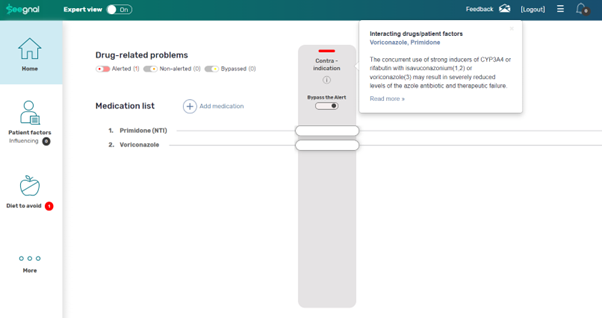
how it Works
Transforming medication safety with patient-tailored prescriptions
Seegnal harnesses cutting-edge technology and personalization to prevent adverse drug reactions and save lives.

"Adverse drug reactions (ADRs) are estimated to be between the fourth and sixth most common cause of death worldwide, taking their place among other prevalent causes of mortality such as heart disease, cancer, and stroke."
“at least one in 20 patients are affected by preventable medication related harm globally and that more than one fourth of preventable harm is severe or life-threatening.”

The Problem: A Hidden Crisis
275K Deaths annually in the USA
1.3M Injuries
6%-12% of Hospitalizations
$534.8B in avoidable costs
The two leading causes of the problem:
“Old Standards”
Current systems focus solely on Drug-to-Drug Interactions (DDI), missing broader safety concerns.
“Alert Fatigue”
Lack of personalization leads to overwhelming alerts, causing clinicians to ignore or disable critical notifications.
The Seegnal Solution - A Paradigm Shift
From DDI Standard
Today’s DDI standard has three main constraints:
It is Generic (one size fits all patients and institutions).
Alerts at a drug level instead of at the prescription level.
Passive - Alert only.
To Patient-Centric as a Standard
Elevating to the new standard brings four core, unique advantages:
Patient-Specific (alerts are patient-specific throughout their journey and are based on current patient conditions).
Prescription level alerting.
Proactive - Alert, re-alert as patient condition changes, and resolve all alerts.
Single drug-lab interaction
Conceptual Workflow
1
Data Collection
Upon opening the patient chart, Seegnal collects hundreds of personal data points from EHR/Genome Labs in real-time.
Proprietary Technology
Our unique technology normalizes multivariate internationally accredited medical data sources into a single database, powered by over 1,500 proprietary algorithms.
2
Single-Alert-View Screen
Unsafe treatments trigger alerts presented in a patented Single-Alert-View screen, requiring immediate physician action—either resolve or bypass the alerts.
3
4
Alternative Drug Mechanism
When a therapy is unsafe, Seegnal instantly computes an alternative suggestion based on the diagnosis and the institution’s drug formulary.
5
EHR Integration
The new medication, dosing, and bypasses are seamlessly integrated back into the EHR, with no personal data stored on Seegnal's servers.
Adaptive Alert Intelligence (AAI)
Seegnal’s AAI manages alerts automatically as new lab results and vital signs are recorded in the patient’s record.
Problem & Solutions
Discover how Seegnal addresses critical challenges in clinical practice with innovative solutions that enhance patient safety, streamline workflows, and save valuable time for healthcare providers.
How Seegnal Works
Addressing Critical Challenges in Clinical Practice beyond Alerts
Problem 1: Time-Consuming Drug Research
Issue:
Clinicians need to spend significant time on their PDAs researching the right drug combinations to avoid severe side effects, detracting from patient care and increasing the risk of errors.
Solution:
Seegnal’s Alternative Drug Mechanism (ADM)
Seegnal’s ADM computes and presents all possible drugs from the institution’s formulary that minimize adverse drug reactions within milliseconds. This instant access to safe alternatives allows clinicians to make informed decisions quickly, reducing the time spent on manual research and enhancing patient safety.
Problem 2: Delayed Lab Results Impacting Therapy
Issue:
Lab results that could affect therapy treatments are often recorded in patient charts long after the clinician-patient interaction, sometimes weeks later. Clinicians do not have the time or capacity to follow up on every test effectively, leading to potential risks in ongoing therapies.
Solution:
Seegnal’s Adaptive Alerting Intelligence (AAI)
Seegnal’s AAI automatically recalculates patient charts in the EMR whenever new lab results or vital signs are recorded. It alerts clinicians to any potential hazards in the current therapy due to these changes, freeing them from the burden of manually tracking updates and ensuring timely interventions.
Problem 3: Cluttered and Complicated EMR Screens
Issue:
EMR screens are often cluttered and not user-friendly, overloading clinicians with information and complicating their work.
Solution:
Seegnal’s Patented Single-Screen View
Seegnal’s Single-Screen View streamlines the clinician’s workflow by removing unnecessary clutter and focusing on what’s critical. Alerts, lab results, and necessary follow-up actions are presented in a clean, intuitive interface, allowing clinicians to address issues quickly and efficiently.
Problem 4: Misidentified Patient Complaints
Issue:
Patient complaints may not indicate a new medical problem but could be side effects of current therapy. If these side effects are not identified promptly, it complicates the therapy and leads to unnecessary re-visits, consuming additional time and resources.
Solution:
Seegnal’s Shared Side Effect Module
This module enables clinicians to quickly determine whether a new complaint is due to side effects from current therapy. By identifying the root cause accurately, clinicians can adjust treatment plans accordingly, reducing unnecessary re-visits and optimizing patient care.
Problem 5: Lack of Time for Dietary Counseling
Issue:
Clinicians often lack the time to explain diet restrictions necessary for avoiding interactions with prescribed drugs, leaving patients without crucial information.
Solution:
Seegnal’s Diet to Avoid Feature
Seegnal’s Diet to Avoid automatically presents any necessary dietary restrictions for the chosen therapy. This allows clinicians to provide patients with quick, actionable dietary guidelines, ensuring that patients are fully informed without taking up valuable consultation time.
Ready to See Seegnal in Action?
What our customers say










